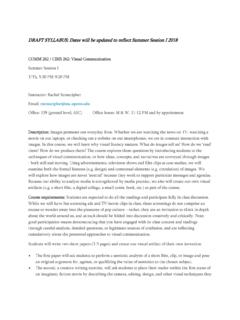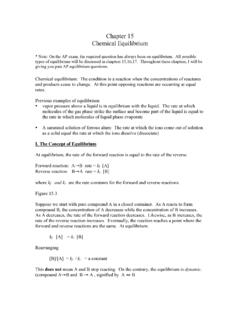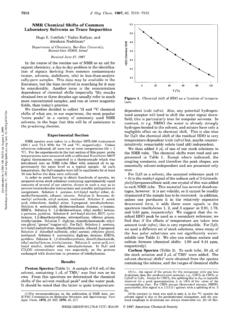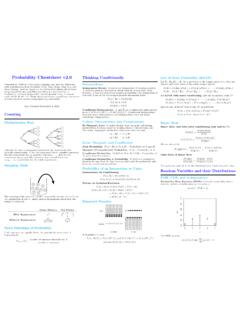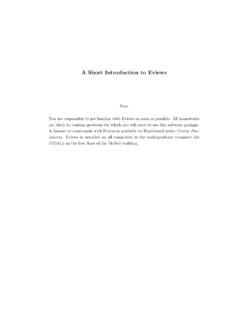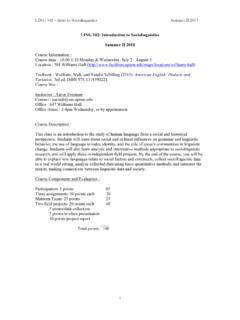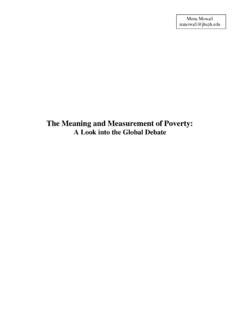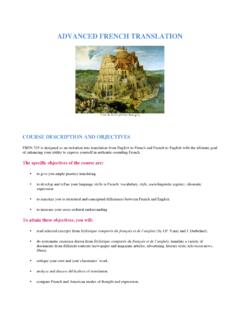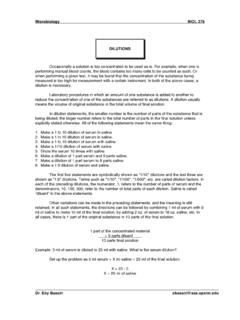Transcription of Introduction to Time Series Regression and Forecasting
1 14-1 Introduction to time Series Regression and Forecasting (SW Chapter 14) time Series data are data collected on the same observational unit at multiple time periods Aggregate consumption and GDP for a country (for example, 20 years of quarterly observations = 80 observations) Yen/$, pound/$ and Euro/$ exchange rates (daily data for 1 year = 365 observations) Cigarette consumption per capita in a state, by year 14-2 Example #1 of time Series data: US rate of price inflation, as measured by the quarterly percentage change in the Consumer Price Index (CPI), at an annual rate 14-3 Example #2: US rate of unemployment 14-4 Why use time Series data? To develop Forecasting models o What will the rate of inflation be next year? To estimate dynamic causal effects o If the Fed increases the Federal Funds rate now, what will be the effect on the rates of inflation and unemployment in 3 months? in 12 months? o What is the effect over time on cigarette consumption of a hike in the cigarette tax?
2 Or, because that is your only option .. o Rates of inflation and unemployment in the US can be observed only over time ! 14-5 time Series data raises new technical issues time lags Correlation over time (serial correlation, autocorrelation) Forecasting models built on Regression methods: o autoregressive (AR) models o autoregressive distributed lag (ADL) models o need not (typically do not) have a causal interpretation Conditions under which dynamic effects can be estimated, and how to estimate them Calculation of standard errors when the errors are serially correlated 14-6 Using Regression Models for Forecasting (SW Section ) Forecasting and estimation of causal effects are quite different objectives. For Forecasting , o 2R matters (a lot!) o Omitted variable bias isn t a problem! o We will not worry about interpreting coefficients in Forecasting models o External validity is paramount: the model estimated using historical data must hold into the (near) future 14-7 Introduction to time Series Data and Serial Correlation (SW Section ) First, some notation and terminology.
3 Notation for time Series data Yt = value of Y in period t. Data set: Y1,..,YT = T observations on the time Series random variable Y We consider only consecutive, evenly-spaced observations (for example, monthly, 1960 to 1999, no missing months) (missing and non-evenly spaced data introduce technical complications) 14-8We will transform time Series variables using lags, first differences, logarithms, & growth rates 14-9 Example: Quarterly rate of inflation at an annual rate ( ) CPI = Consumer Price Index (Bureau of Labor Statistics) CPI in the first quarter of 2004 (2004:I) = CPI in the second quarter of 2004 (2004:II) = Percentage change in CPI, 2004:I to 2004:II = = = Percentage change in CPI, 2004:I to 2004:II, at an annual rate = 4 = (percent per year) Like interest rates, inflation rates are (as a matter of convention) reported at an annual rate. Using the logarithmic approximation to percent changes yields 4 100 [log( ) log( )] = 14-10 Example: US CPI inflation its first lag and its change 14-11 Autocorrelation The correlation of a Series with its own lagged values is called autocorrelation or serial correlation.
4 The first autocorrelation of Yt is corr(Yt,Yt 1) The first autocovariance of Yt is cov(Yt,Yt 1) Thus corr(Yt,Yt 1) = 11cov( ,)var( ) var()ttttYYYY = 1 These are population correlations they describe the population joint distribution of (Yt, Yt 1) 14-12 14-13 Sample autocorrelations The jth sample autocorrelation is an estimate of the jth population autocorrelation: j = cov( ,)var( )ttjtYYY where cov( ,)ttjYY = 1,1,11()( )TtjTtj TjtjYYY YT where 1,jTY is the sample average of Yt computed over observations t = j+1,..,T. NOTE: o the summation is over t=j+1 to T (why?) o The divisor is T, not T j (this is the conventional definition used for time Series data) 14-14 Example: Autocorrelations of: (1) the quarterly rate of inflation (2) the quarter-to-quarter change in the quarterly rate of inflation 14-15 The inflation rate is highly serially correlated ( 1 = .84) Last quarter s inflation rate contains much information about this quarter s inflation rate The plot is dominated by multiyear swings But there are still surprise movements!
5 14-16 Other economic time Series : 14-17 Other economic time Series , ctd: 14-18 Stationarity: a key requirement for external validity of time Series Regression Stationarity says that history is relevant: For now, assume that Yt is stationary (we return to this later). 14-19 Autoregressions (SW Section ) A natural starting point for a Forecasting model is to use past values of Y (that is, Yt 1, Yt 2,..) to forecast Yt. An autoregression is a Regression model in which Yt is regressed against its own lagged values. The number of lags used as regressors is called the order of the autoregression. o In a first order autoregression, Yt is regressed against Yt 1 o In a pth order autoregression, Yt is regressed against Yt 1,Yt 2,..,Yt p. 14-20 The First Order Autoregressive (AR(1)) Model The population AR(1) model is Yt = 0 + 1Yt 1 + ut 0 and 1 do not have causal interpretations if 1 = 0, Yt 1 is not useful for Forecasting Yt The AR(1) model can be estimated by OLS Regression of Yt against Yt 1 Testing 1 = 0 v.
6 1 0 provides a test of the hypothesis that Yt 1 is not useful for Forecasting Yt 14-21 Example: AR(1) model of the change in inflation Estimated using data from 1962:I 2004:IV: tInf = Inft 1 2R = ( ) ( ) Is the lagged change in inflation a useful predictor of the current change in inflation? t = .238/.096 = > (in absolute value) Reject H0: 1 = 0 at the 5% significance level Yes, the lagged change in inflation is a useful predictor of current change in inflation but the 2R is pretty low! 14-22 Example: AR(1) model of inflation stata First, let stata know you are using time Series data generate time =q(1959q1)+_n-1; _n is the observation no. So this command creates a new variable time that has a special quarterly date format format time %tq; Specify the quarterly date format sort time ; Sort by time tsset time ; Let stata know that the variable time is the variable you want to indicate the time scale 14-23 Example: AR(1) model of inflation stata , ctd.
7 Gen lcpi = log(cpi); variable cpi is already in memory . gen inf = 400*(lcpi[_n]-lcpi[_n-1]); quarterly rate of inflation at an annual rate This creates a new variable, inf, the nth observation of which is 400 times the difference between the nth observation on lcpi and the n-1 th observation on lcpi, that is, the first difference of lcpi compute first 8 sample autocorrelations . corrgram inf if tin(1960q1,2004q4), noplot lags(8); LAG AC PAC Q Prob>Q ---------------------------------------- - 1 2 3 4 5 6 7 8 if tin(1962q1,2004q4) is stata time Series syntax for using only observations between 1962q1 and 1999q4 (inclusive).
8 The tin(.,.) option requires defining the time scale first, as we did above 14-24 Example: AR(1) model of inflation stata , ctd . gen dinf = inf[_n]-inf[_n-1]; . reg dinf if tin(1962q1,2004q4), r; is the first lag of dinf Linear Regression Number of obs = 172 F( 1, 170) = Prob > F = R-squared = Root MSE = ---------------------------------------- -------------------------------------- | Robust dinf | Coef. Std. Err. t P>|t| [95% Conf. Interval] -------------+-------------------------- -------------------------------------- dinf | L1. | .0965034 _cons | .0171013 .1268831.
9 2675707 ---------------------------------------- -------------------------------------- . dis "Adjusted Rsquared = " _result(8); Adjusted Rsquared = .05082278 14-25 Forecasts: terminology and notation Predicted values are in-sample (the usual definition) Forecasts are out-of-sample in the future Notation: o YT+1|T = forecast of YT+1 based on YT,YT 1,.., using the population (true unknown) coefficients o 1| TTY = forecast of YT+1 based on YT,YT 1,.., using the estimated coefficients, which are estimated using data through period T. o For an AR(1): YT+1|T = 0 + 1YT 1| TTY = 0 + 1 YT, where 0 and 1 are estimated using data through period T. 14-26 Forecast errors The one-period ahead forecast error is, forecast error = YT+1 1| TTY The distinction between a forecast error and a residual is the same as between a forecast and a predicted value: a residual is in-sample a forecast error is out-of-sample the value of YT+1 isn t used in the estimation of the Regression coefficients 14-27 Example: Forecasting inflation using an AR(1) AR(1) estimated using data from 1962:I 2004:IV: tInf = Inft 1 Inf2004:III = (units are percent, at an annual rate) Inf2004:IV = Inf2004:IV = = The forecast of Inf2005:I is: 2005: |2000:IIVInf = = so 2005: |2000:IIVInf = Inf2004:IV + 2005: |2000:IIVInf = = 14-28 The AR(p) model: using multiple lags for Forecasting The pth order autoregressive model (AR(p)) is Yt = 0 + 1Yt 1 + 2Yt 2 +.
10 + pYt p + ut The AR(p) model uses p lags of Y as regressors The AR(1) model is a special case The coefficients do not have a causal interpretation To test the hypothesis that Yt 2,..,Yt p do not further help forecast Yt, beyond Yt 1, use an F-test Use t- or F-tests to determine the lag order p Or, better, determine p using an information criterion (more on this ) 14-29 Example: AR(4) model of inflation tInf = .02 .26 Inft 1 .32 Inft 2 + .16 Inft 3 .03 Inft 4, (.12) (.09) (.08) (.08) (.09) 2R = F-statistic testing lags 2, 3, 4 is (p-value < .001) 2R increased from .05 to .18 by adding lags 2, 3, 4 So, lags 2, 3, 4 (jointly) help to predict the change in inflation, above and beyond the first lag both in a statistical sense (are statistically significant) and in a substantive sense (substantial increase in the 2R) 14-30 Example: AR(4) model of inflation stata . reg dinf L(1/4).dinf if tin(1962q1,2004q4), r; Linear Regression Number of obs = 172 F( 4, 167) = Prob > F = R-squared = Root MSE = ---------------------------------------- -------------------------------------- | Robust dinf | Coef.
